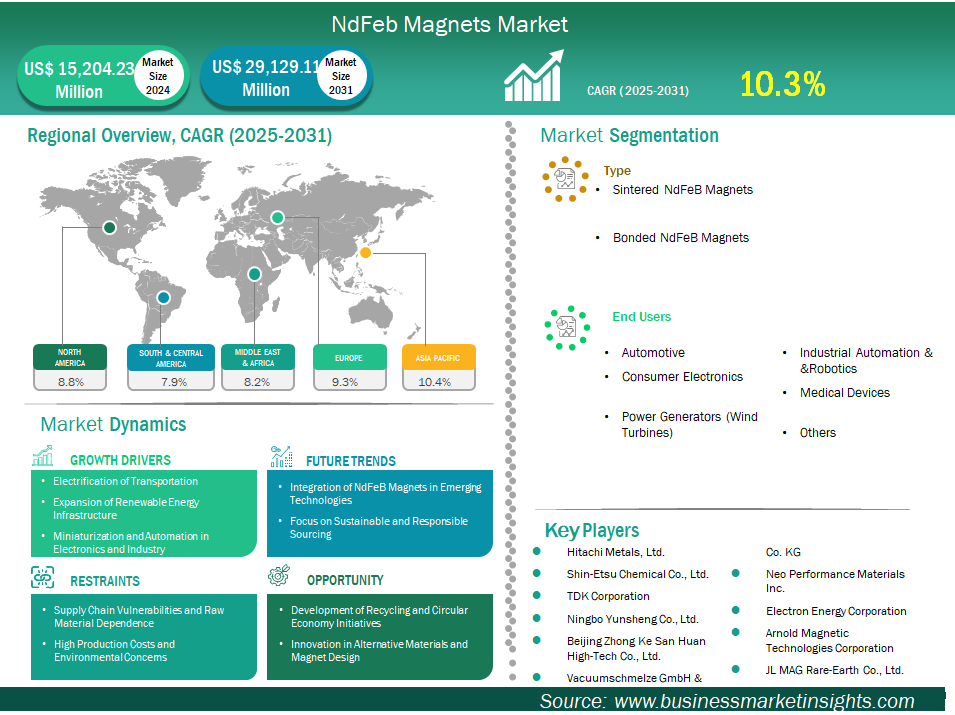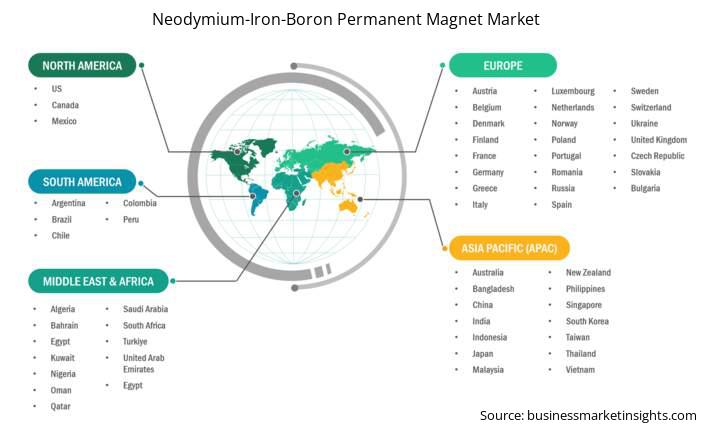Neodymium-Iron-Boron Permanent Magnet Market Outlook (2021-2031)
No. of Pages: 200 | Report Code: BMIPUB00031696 | Category: Chemicals and Materials
No. of Pages: 200 | Report Code: BMIPUB00031696 | Category: Chemicals and Materials
The neodymium iron boron (NdFeB) permanent magnet market size is expected to reach US$ 29,129.11 million by 2031 from US$ 15,204.23 million in 2024. The market is estimated to record a CAGR of 10.3% from 2025 to 2031.
The global NdFeB (neodymium iron boron) magnet market is experiencing robust growth driven by the accelerating adoption of high-performance, energy-efficient technologies across multiple industries. NdFeB magnets are recognized for their superior magnetic strength, compact size, and versatility, making them indispensable in applications ranging from electric vehicles and wind turbines to consumer electronics and medical devices. The market is shaped by a confluence of factors, including the global shift toward renewable energy, the rapid expansion of electric mobility, and the ongoing miniaturization and automation of electronic products.
Key trends include increased focus on sustainability, with initiatives aimed at recycling rare earth materials and reducing dependency on critical raw materials. Technological innovation is also prominent, with manufacturers investing in advanced production processes and collaborative research to enhance magnet performance, durability, and environmental compatibility. While the market is highly competitive and dominated by established players—especially in Asia—new opportunities are emerging for companies that can offer differentiated value, such as improved quality, supply chain resilience, and reduced carbon footprints.

Key segments that contributed to the derivation of the neodymium iron boron (NdFeB) permanent magnet market analysis are drive type, propulsion, sales channel, and geography.
The global push toward electric vehicles (EVs) is a major driver for NdFeB magnet demand. As governments and industries strive to reduce carbon emissions, the adoption of EVs is accelerating, requiring high-performance permanent magnets for efficient motors and drivetrains. NdFeB magnets offer superior magnetic strength and energy efficiency, making them essential for electric powertrains. This trend is further supported by regulatory mandates, consumer preferences for cleaner transportation, and investments in charging infrastructure. The automotive sector’s transformation is expected to sustain robust growth in NdFeB magnet usage, with manufacturers scaling up production to meet the needs of both passenger and commercial electric vehicles.
As concerns about resource scarcity and environmental impact grow, there is a significant opportunity to develop and scale up recycling technologies for NdFeB magnets. Recovering rare earth elements from end-of-life products, industrial scrap, and electronic waste can reduce dependence on primary mining and lower production costs. Governments, research institutions, and industry players are increasingly investing in recycling infrastructure and collaborative projects to establish a circular economy for rare earth materials. These efforts not only enhance supply chain resilience but also align with global sustainability goals, creating new business opportunities for companies specializing in magnet recycling and sustainable materials management.
By type, sintered neodymium iron boron (NdFeB) permanent magnet dominated the market in 2024 – Sintered NdFeB magnets are favored due to their superior magnetic strength and energy density, which enable them to deliver outstanding performance in demanding applications such as electric vehicle motors, wind turbine generators, and industrial automation systems. Their dominance is further driven by the increasing global demand for high-efficiency, compact, and durable magnet solutions in sectors undergoing rapid electrification and automation. Sintered NdFeB magnets are produced through a powder metallurgy process, resulting in robust magnets with excellent temperature stability and resistance to demagnetization, making them the preferred choice for high-performance industrial and automotive applications.
By end-users, the automotive sector—and particularly the electric vehicle (EV) segment—emerged as the leading end-user and application for NdFeB magnets. This dominance was driven by the rapid global adoption of electric vehicles, where NdFeB magnets are essential components in high-efficiency motors and drivetrains. The magnets’ superior magnetic strength, compact size, and ability to operate efficiently at high temperatures made them indispensable for improving the performance, range, and reliability of EVs. While other sectors such as wind energy, consumer electronics, and industrial automation also contributed significantly to NdFeB magnet demand, the automotive industry’s growth outpaced these segments due to supportive government policies, stricter emissions regulations, and increased consumer preference for sustainable transportation.
Neodymium-Iron-Boron Permanent Magnet Market Report Highlights
Report Attribute
Details
Market size in 2024
US$ 15,204.23 Million
Market Size by 2031
US$ 29,129.11 Million
Global CAGR (2025 - 2031) 10.3%
Historical Data
2021-2023
Forecast period
2025-2031
Segments Covered
By Type
By End-Users
Regions and Countries Covered
North America
Europe
Asia-Pacific
South and Central America
Middle East and Africa
Market leaders and key company profiles
The "Neodymium iron boron (NdFeB) permanent magnet market Outlook (2021–2031)" report provides a detailed analysis of the market covering below areas:

The geographical scope of the Neodymium iron boron (NdFeB) permanent magnet market report is divided into five regions: North America, Asia Pacific, Europe, Middle East & Africa, and South & Central America. Asia-Pacific and specifically China dominated the global NdFeB magnet market. China’s leadership is rooted in its comprehensive control over the rare earth supply chain, advanced manufacturing capabilities, and significant domestic demand for NdFeB magnets. The country produces the vast majority of the world’s rare earth elements and is the largest producer and consumer of NdFeB magnets, with major production bases such as Zhejiang playing key roles.
China’s dominance is further reinforced by its aggressive push toward electric vehicles and renewable energy, both of which rely heavily on high-performance permanent magnets. Government policies supporting EV adoption and wind power installations have driven strong local consumption and innovation, making China the central hub for NdFeB magnet production and application.
Other Asia-Pacific countries, including Japan and South Korea, also contribute significantly due to their sophisticated manufacturing sectors and technological expertise, but China remains the clear leader in both output and market influence.
The Neodymium iron boron (NdFeB) permanent magnet market is evaluated by gathering qualitative and quantitative data post primary and secondary research, which includes important corporate publications, association data, and databases. A few of the key developments in the Neodymium iron boron (NdFeB) permanent magnet market are:
The Neodymium-Iron-Boron Permanent Magnet Market is valued at US$ 15,204.23 Million in 2024, it is projected to reach US$ 29,129.11 Million by 2031.
As per our report Neodymium-Iron-Boron Permanent Magnet Market, the market size is valued at US$ 15,204.23 Million in 2024, projecting it to reach US$ 29,129.11 Million by 2031. This translates to a CAGR of approximately 10.3% during the forecast period.
The Neodymium-Iron-Boron Permanent Magnet Market report typically cover these key segments-
The historic period, base year, and forecast period can vary slightly depending on the specific market research report. However, for the Neodymium-Iron-Boron Permanent Magnet Market report:
The Neodymium-Iron-Boron Permanent Magnet Market is populated by several key players, each contributing to its growth and innovation. Some of the major players include:
The Neodymium-Iron-Boron Permanent Magnet Market report is valuable for diverse stakeholders, including:
Essentially, anyone involved in or considering involvement in the Neodymium-Iron-Boron Permanent Magnet Market value chain can benefit from the information contained in a comprehensive market report.